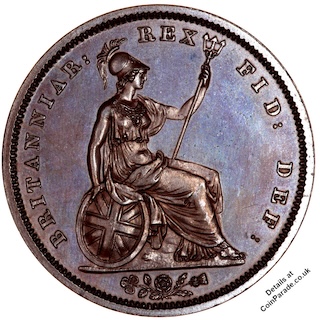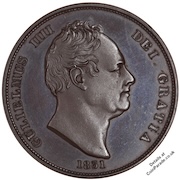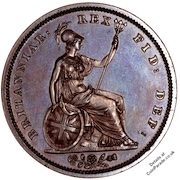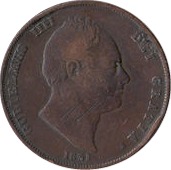
 The 1831 Penny - William IV - Proof
The 1831 Penny - William IV - ProofCopper penny of King William IV minted in 1831. Note that William IV is shown on the coin in Latin as GULIELMUS IIII.
This is the proof version, struck for the coronation of King William IV.
This is a large coin with diameter 34mm and weight of 19g. The design was in general circulation, the proof made for the coronation. There is a variant in the proof where the orientation can be up-down or up-up.
The Obverse shows the bare head of the king facing right. Legend is "GULIELMUS IIII DEI GRATIA". Date below.
The edge is plain.
 The Reverse, by William Wyon, shows Britannia seated, holding a trident and shield. In the exergue is an intertwined rose, thistle and shamrock. Legend is "BRITANNIAR: REX FID: DEF:".
The Reverse, by William Wyon, shows Britannia seated, holding a trident and shield. In the exergue is an intertwined rose, thistle and shamrock. Legend is "BRITANNIAR: REX FID: DEF:".Image credit: Museums Victoria
Mintage: Not known
Minted at The Royal Mint
SCBC: 3845
More information (monarch, year, mint, country, category) can be found below coin listings.
Below are some coins currently being offered on eBay. As an eBay Partner, We may be compensated if you make a purchase.
List items on:
List items on:
Remember 1831 ?
The Monarch is William IV, his Coronation year. Prime Minister is Charles Grey, 2nd Earl Grey (Whig). Andrew Jackson (Democrat) is President of USA. Royal Astronomical Society receives its Royal Charter. The new London Bridge is opened. Michael Faraday demonstrates electromagnetic induction and constructs the first dynamo. The Truck Act prohibits payment of wages other than in cash.
William IV (1830-1837)
 William IV was King of the United Kingdom of Great Britain and Ireland and King of Hanover from 26 June 1830 until his death. He was the third son of King George III, born 21 August 1765. William married Adelaide of Saxe-Meiningen and had two daughters (Charlotte and Elizabeth) but was also known to have ten illegitimate children with actress Dorithea Jordan.
William IV was King of the United Kingdom of Great Britain and Ireland and King of Hanover from 26 June 1830 until his death. He was the third son of King George III, born 21 August 1765. William married Adelaide of Saxe-Meiningen and had two daughters (Charlotte and Elizabeth) but was also known to have ten illegitimate children with actress Dorithea Jordan.Note that on coins, William IV is often written as GULIELMUS IIII. William IV is sometimes known as the 'Sailor King'. On his death the throne passed to his niece, Victoria.
Category: Penny
The Penny is one of the most famous British coins. The coin itself has been around since 600AD and at various times has been struck in silver, copper and bronze. Originally split into halfpennies and farthing, it is now itself the least denomination coin currently in circulation. Made from copper (actually copper plated steel). Originally there were 12 pennies in one shilling and 240 pennies in £1; since decimalisation in 1971 there are 100 new pence in one pound.
Composition: Early pennies were Silver, then Copper, Bronze and Copper coated steel.
Which Mint: The Royal Mint
The Royal Mint is the designated place for the UK to mint coins. It dates back well over 1000 years and is a Government-owned company. Formed in the reign of Alfred the Great about the year 886, during the period 1279-1812 it was generally referred to as The Tower Mint as it was housed at the Tower of London. The Master of The Royal Mint has included famous figures such as Sir Isaac Newton.
Since 2010 it has operated as Royal Mint Ltd, a company owned by HM Treasury, under an exclusive contract to supply all coinage for the UK although it also produces medals and coins for other countries. It is currently located at Llantrisant, Wales.
Country of Origin: United Kingdom
The United Kingdom (UK) is the Union of England, Scotland, Wales and Northern Ireland. It is often refered to as Great Britain (GBR). It has a long, rich history. The orignal coinage was Pounds, Shillings and Pence but since decimalisation on 15 February 1971, it is £1 = 100p, that is One Pound = 100 pence. The coinage of the UK is also a long history, the Royal Mint being established as long ago as 886AD when coins were hammered. Today there is perhaps 30 billion coins in circulation, and many (numismatic) collectors coins and sets are issued frequently in gold, silver and other metals.

![1831 William IV Penny 1d coin [32555]](https://i.ebayimg.com/images/g/dDEAAOSw1s5oH0~4/s-l225.jpg)






